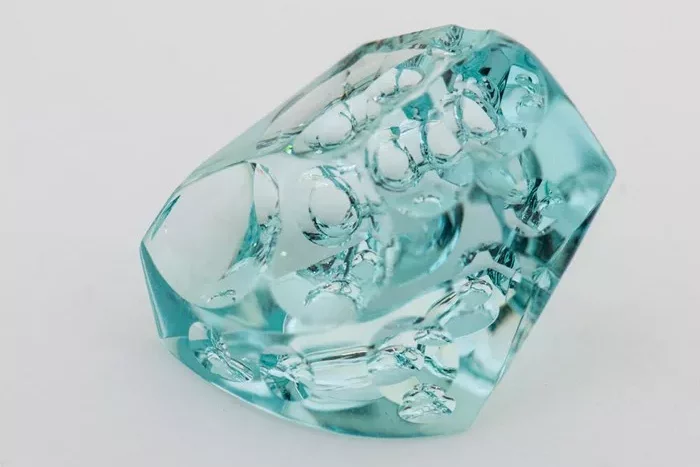Aquamarine, with its serene blue hues reminiscent of tranquil ocean waters, has captivated humanity for centuries. Beyond its aesthetic allure, this gemstone harbors a fascinating geological history, woven through the depths of the Earth over millions of years. In this article, we delve into the intricacies of aquamarine, from its formation deep within the Earth’s crust to its journey to adorn the jewelry collections of enthusiasts worldwide.
Understanding Aquamarine
Aquamarine belongs to the beryl family of minerals, alongside emerald and morganite. Its name, derived from the Latin words “aqua” and “marina,” translates to “water of the sea,” a fitting description of its captivating blue-green hues. The gemstone’s coloration stems from trace amounts of iron impurities within its crystal structure.
Renowned for its clarity and transparency, aquamarine often forms in large, hexagonal crystals. Its color can vary from pale sky blue to deeper shades reminiscent of the ocean’s depths. Beyond its aesthetic appeal, aquamarine has been attributed with various metaphysical properties, including promoting tranquility, communication, and courage.
How Aquamarine is Formed
The formation of aquamarine is a complex process that unfolds over millions of years. It typically occurs in pegmatite veins, which are formed during the final stages of magma crystallization within the Earth’s crust. As magma cools and solidifies, it creates pockets where elements and minerals can concentrate, giving rise to gemstone-bearing environments.
The presence of beryllium, aluminum, silicon, and other elements within these pockets provides the necessary ingredients for aquamarine formation. Under specific conditions of temperature and pressure, beryl precursor minerals undergo crystallization, gradually transforming into aquamarine over geological timescales.
The incorporation of trace elements such as iron during crystallization imbues aquamarine with its characteristic blue coloration. The exact hue and intensity of the gemstone depend on factors such as the concentration of impurities, the duration of crystallization, and the geological environment in which it forms.
Mining and Extraction
Aquamarine deposits are found in various geological settings around the world, ranging from granite pegmatites to metamorphic rocks. Brazil, Nigeria, Madagascar, and Pakistan are among the leading producers of aquamarine, each boasting unique geological formations conducive to gemstone formation.
Mining aquamarine typically involves a combination of surface and underground extraction methods. In open-pit mining, large-scale excavation equipment is employed to uncover gem-bearing veins within pegmatite deposits. Underground mining may also be utilized in instances where gemstone-bearing veins extend deep beneath the Earth’s surface.
Once extracted, aquamarine-bearing rock is processed to isolate the gemstones. This process involves crushing the ore and separating the valuable minerals through techniques such as gravity separation, flotation, and magnetic separation. The resulting concentrate undergoes further refining to yield gem-quality aquamarine specimens.
Gemstone Cutting and Processing
Upon extraction, raw aquamarine undergoes a series of meticulous processes to transform it into exquisite gemstones ready for jewelry fabrication. Skilled lapidaries employ a combination of traditional techniques and modern technologies to maximize the gemstone’s brilliance, clarity, and overall aesthetic appeal.
The first step in gemstone processing involves cleaving or sawing the rough aquamarine into manageable pieces. These pieces are then shaped and faceted using precision cutting tools to enhance their optical properties. The choice of cut, whether it be a classic emerald cut or a contemporary brilliant cut, is determined by factors such as the gemstone’s size, clarity, and intended use.
Following cutting, aquamarine gemstones undergo polishing to achieve a lustrous finish and impeccable clarity. This process involves successive stages of abrasion with finer and finer grits until the desired level of smoothness and brilliance is achieved. The final polished gemstones are then inspected for quality and sorted according to color, size, and clarity.
Care and Maintenance
While aquamarine is renowned for its durability, proper care and maintenance are essential to preserve its beauty and luster over time. As with all gemstones, aquamarine should be protected from harsh chemicals, extreme temperatures, and physical abrasion to prevent damage or degradation.
To clean aquamarine jewelry, gentle methods such as warm soapy water and a soft brush are recommended. Avoid exposing aquamarine gemstones to ultrasonic or steam cleaning devices, as these can potentially damage the stone or loosen settings. Store aquamarine jewelry separately from other pieces to prevent scratching or chipping.
Periodic professional cleaning and inspection by a reputable jeweler can help maintain the integrity of aquamarine jewelry and address any potential issues such as loose settings or surface damage. With proper care, aquamarine jewelry can be cherished for generations to come, its beauty enduring as a testament to the marvels of nature’s craftsmanship.
Conclusion
In conclusion, aquamarine’s allure extends far beyond its captivating color and clarity, encompassing a rich geological narrative that spans millions of years. From its formation deep within the Earth’s crust to its transformation into exquisite gemstones, aquamarine embodies the intersection of nature’s beauty and human craftsmanship. By understanding the intricate processes that govern its existence, we gain a deeper appreciation for this timeless gemstone and the geological forces that shape our world.


